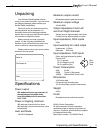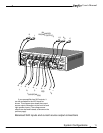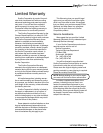
12
User's Manual
If your speakers can be biamped, the
Cinema Grand Amplifier can be configured to
provide a very powerful stereo system.
A speaker which can be biamped or
biwired will have two sets of binding posts.
Sometimes these posts are joined with
shorting links for normal operation.
Make sure that any links are
removed when you want to biamp or
biwire the speakers.
Each speaker can be driven by two
amplifier channels, one to drive the woofer
and one for the upper range. You will need to
use four amplifier channels to run two speak-
ers.
If you use the Cinema Grand Amplifier for
biamping, then a total of three speakers can
be connected. You will need an extra two
channel amplifier if you want to run the rear
speakers in a home theater system.
Biamping
Tweeter
Inputs
Woofer
System Configurations
Output connections
• Connect the amplifier’s right rear
output to the right speaker’s woofer
input terminals and connect the
amplifier’s right front current source
output to the right speaker’s upper
range input terminals. If you prefer,
you could use the right front voltage
source instead.
• Connect the amplifier’s left rear output
to the left speaker’s woofer input
terminals and connect the amplifier’s
left front current source output to the
left speaker’s upper range input
terminals. If you prefer, you could use
the left front voltage source instead.
Input connections
Each amplifier channel has two RCA
inputs which are connected together inter-
nally.
• Connect the preamp’s stereo output to
the front channel RCA jacks. Then
install short interconnects from the
other unused front RCA jacks across
to the rear channel RCA jacks. In this
way, the front and rear amplifier
channels are fed with the same signal
from your preamp.
• Note: you cannot use balanced cables
in, with RCA out, or RCA in with
balanced out.
If you have an external active crossover,
then you can greatly increase the efficiency of
your system. The crossover will split the
preamp signal into two frequency ranges. The
rear channel amplifier will receive the low
frequency range, and the front channel
amplifier will receive the higher range. This is
efficient because each channel only amplifies
signals within the frequency range of the
speaker element they are driving. Little power
is wasted. Make sure that you set the cross-
over point of your active crossover to match
the crossover point of your speakers.


















